Mental Health Promotion at University
VerifiedAdded on 2020/06/04
|7
|2158
|192
AI Summary
This assignment delves into the crucial topic of mental health promotion within a university context. It examines various interventions and programs designed to enhance student well-being, focusing on their effectiveness in addressing mental health challenges. The analysis also considers the role of peer support, student ambassadors, and university resources in creating a supportive environment for students' mental health.
Contribute Materials
Your contribution can guide someone’s learning journey. Share your
documents today.

Health promotion
Secure Best Marks with AI Grader
Need help grading? Try our AI Grader for instant feedback on your assignments.
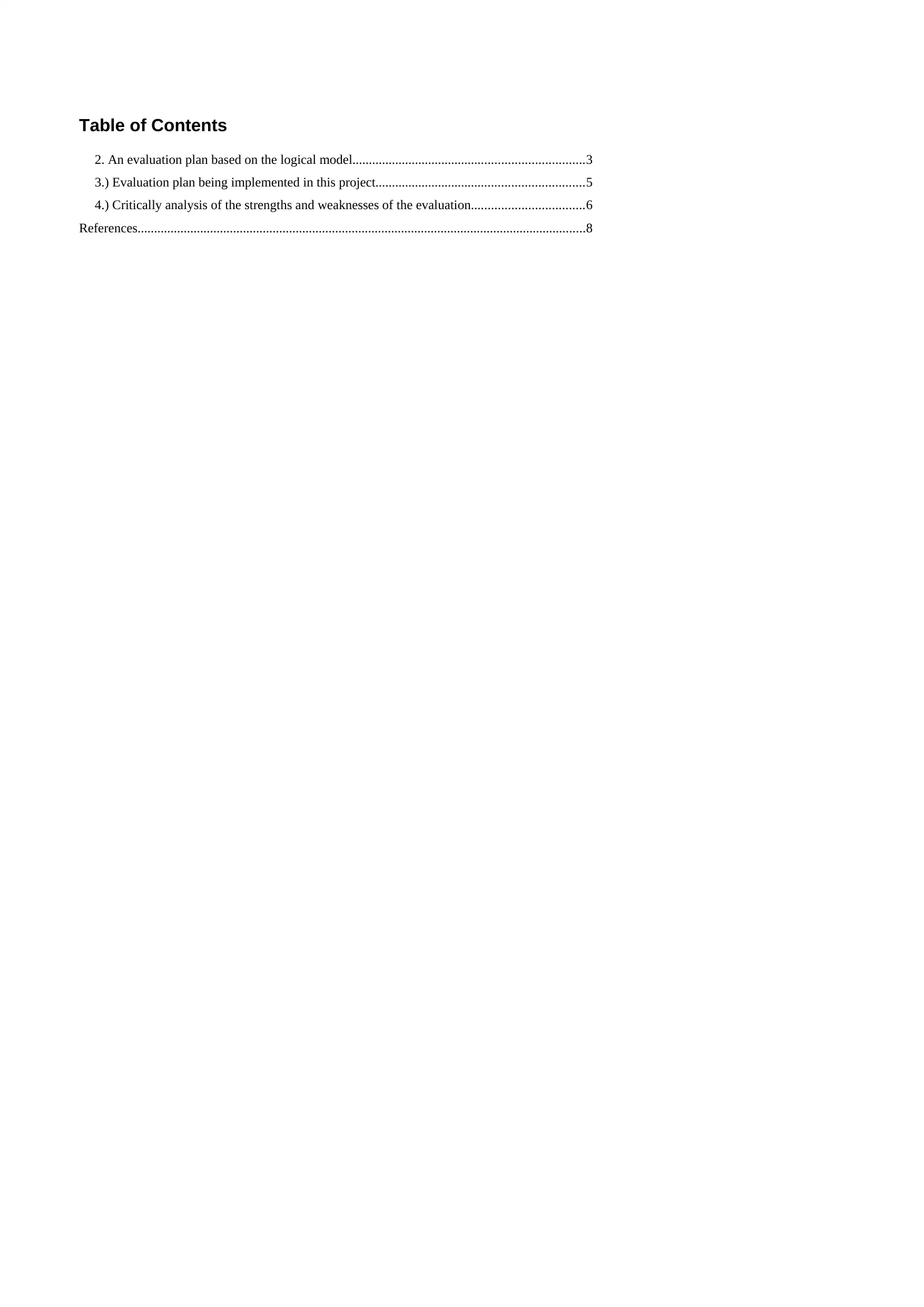
Table of Contents
2. An evaluation plan based on the logical model......................................................................3
3.) Evaluation plan being implemented in this project...............................................................5
4.) Critically analysis of the strengths and weaknesses of the evaluation..................................6
References........................................................................................................................................8
2. An evaluation plan based on the logical model......................................................................3
3.) Evaluation plan being implemented in this project...............................................................5
4.) Critically analysis of the strengths and weaknesses of the evaluation..................................6
References........................................................................................................................................8
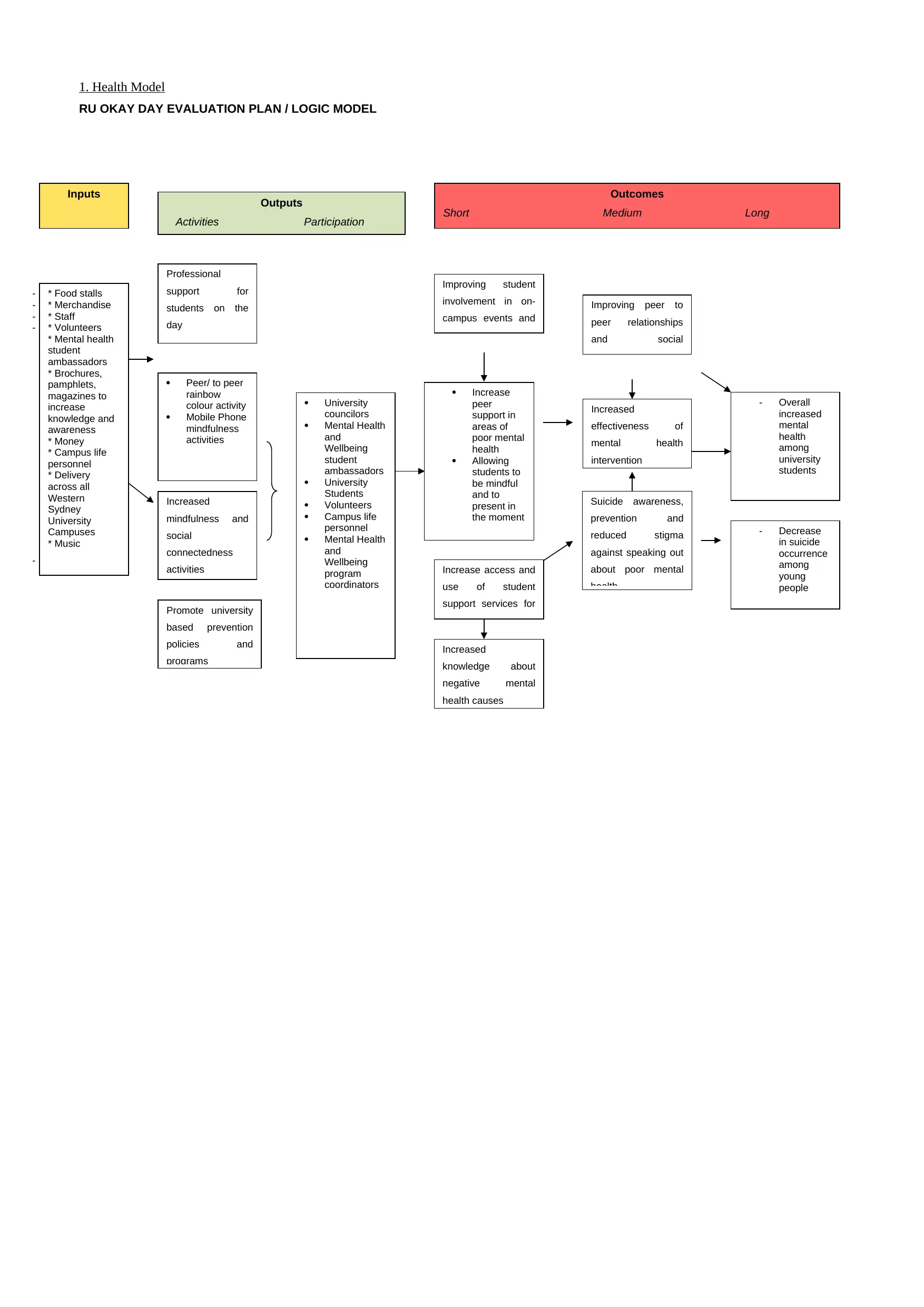
1. Health Model
RU OKAY DAY EVALUATION PLAN / LOGIC MODEL
- * Food stalls
- * Merchandise
- * Staff
- * Volunteers
* Mental health
student
ambassadors
* Brochures,
pamphlets,
magazines to
increase
knowledge and
awareness
* Money
* Campus life
personnel
* Delivery
across all
Western
Sydney
University
Campuses
* Music
-
Professional
support for
students on the
day
Increased
mindfulness and
social
connectedness
activities
University
councilors
Mental Health
and
Wellbeing
student
ambassadors
University
Students
Volunteers
Campus life
personnel
Mental Health
and
Wellbeing
program
coordinators
Peer/ to peer
rainbow
colour activity
Mobile Phone
mindfulness
activities
Improving student
involvement in on-
campus events and
activities
Inputs Outputs
Activities Participation
Outcomes
Short Medium Long
Promote university
based prevention
policies and
programs
Suicide awareness,
prevention and
reduced stigma
against speaking out
about poor mental
health
Increased
knowledge about
negative mental
health causes
Increase access and
use of student
support services for
mental health
Increase
peer
support in
areas of
poor mental
health
Allowing
students to
be mindful
and to
present in
the moment
- Decrease
in suicide
occurrence
among
young
people
Improving peer to
peer relationships
and social
connectedness
Increased
effectiveness of
mental health
intervention
- Overall
increased
mental
health
among
university
students
RU OKAY DAY EVALUATION PLAN / LOGIC MODEL
- * Food stalls
- * Merchandise
- * Staff
- * Volunteers
* Mental health
student
ambassadors
* Brochures,
pamphlets,
magazines to
increase
knowledge and
awareness
* Money
* Campus life
personnel
* Delivery
across all
Western
Sydney
University
Campuses
* Music
-
Professional
support for
students on the
day
Increased
mindfulness and
social
connectedness
activities
University
councilors
Mental Health
and
Wellbeing
student
ambassadors
University
Students
Volunteers
Campus life
personnel
Mental Health
and
Wellbeing
program
coordinators
Peer/ to peer
rainbow
colour activity
Mobile Phone
mindfulness
activities
Improving student
involvement in on-
campus events and
activities
Inputs Outputs
Activities Participation
Outcomes
Short Medium Long
Promote university
based prevention
policies and
programs
Suicide awareness,
prevention and
reduced stigma
against speaking out
about poor mental
health
Increased
knowledge about
negative mental
health causes
Increase access and
use of student
support services for
mental health
Increase
peer
support in
areas of
poor mental
health
Allowing
students to
be mindful
and to
present in
the moment
- Decrease
in suicide
occurrence
among
young
people
Improving peer to
peer relationships
and social
connectedness
Increased
effectiveness of
mental health
intervention
- Overall
increased
mental
health
among
university
students
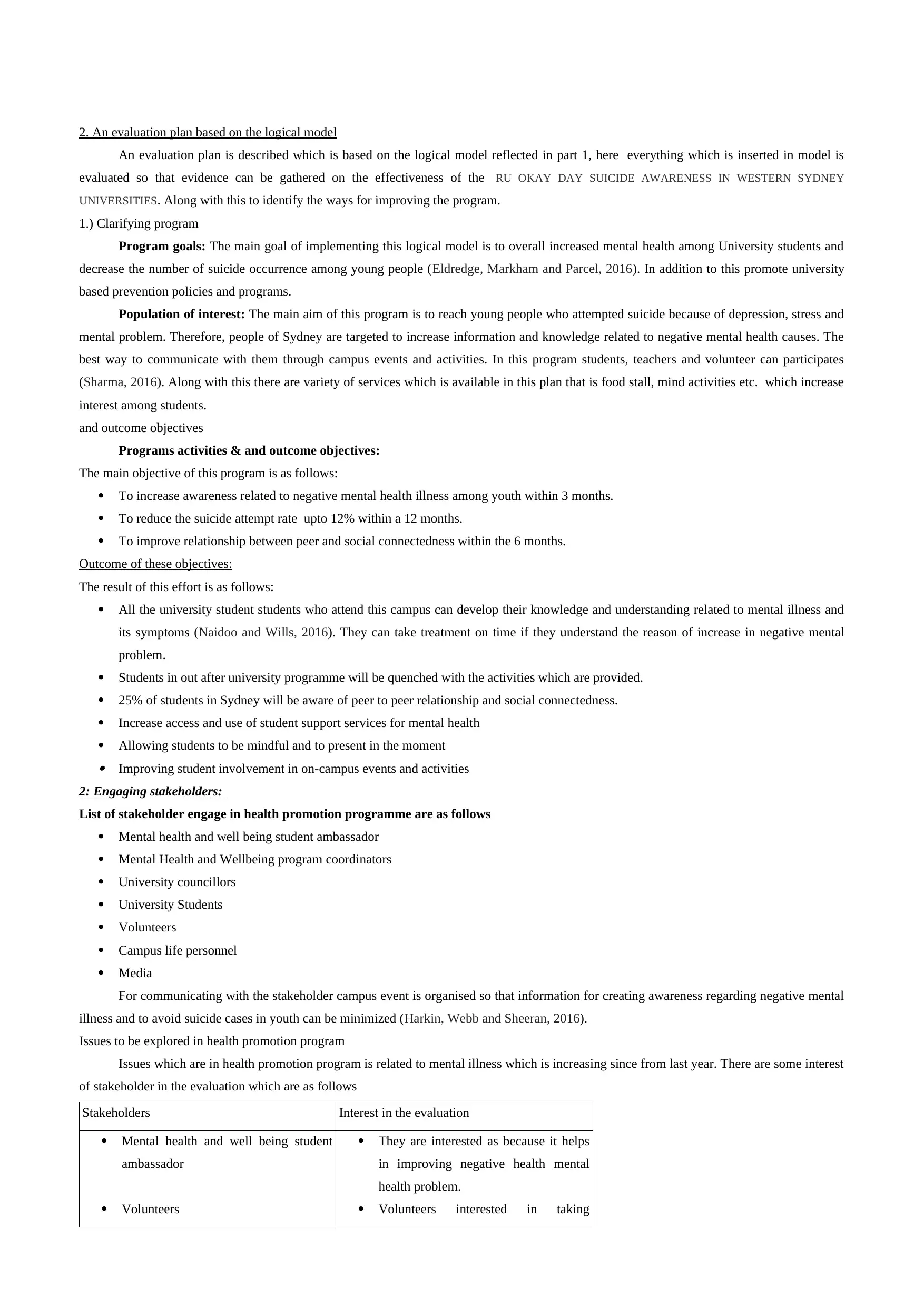
2. An evaluation plan based on the logical model
An evaluation plan is described which is based on the logical model reflected in part 1, here everything which is inserted in model is
evaluated so that evidence can be gathered on the effectiveness of the RU OKAY DAY SUICIDE AWARENESS IN WESTERN SYDNEY
UNIVERSITIES. Along with this to identify the ways for improving the program.
1.) Clarifying program
Program goals: The main goal of implementing this logical model is to overall increased mental health among University students and
decrease the number of suicide occurrence among young people (Eldredge, Markham and Parcel, 2016). In addition to this promote university
based prevention policies and programs.
Population of interest: The main aim of this program is to reach young people who attempted suicide because of depression, stress and
mental problem. Therefore, people of Sydney are targeted to increase information and knowledge related to negative mental health causes. The
best way to communicate with them through campus events and activities. In this program students, teachers and volunteer can participates
(Sharma, 2016). Along with this there are variety of services which is available in this plan that is food stall, mind activities etc. which increase
interest among students.
and outcome objectives
Programs activities & and outcome objectives:
The main objective of this program is as follows:
To increase awareness related to negative mental health illness among youth within 3 months.
To reduce the suicide attempt rate upto 12% within a 12 months.
To improve relationship between peer and social connectedness within the 6 months.
Outcome of these objectives:
The result of this effort is as follows:
All the university student students who attend this campus can develop their knowledge and understanding related to mental illness and
its symptoms (Naidoo and Wills, 2016). They can take treatment on time if they understand the reason of increase in negative mental
problem.
Students in out after university programme will be quenched with the activities which are provided.
25% of students in Sydney will be aware of peer to peer relationship and social connectedness.
Increase access and use of student support services for mental health
Allowing students to be mindful and to present in the moment Improving student involvement in on-campus events and activities
2: Engaging stakeholders:
List of stakeholder engage in health promotion programme are as follows
Mental health and well being student ambassador
Mental Health and Wellbeing program coordinators
University councillors
University Students
Volunteers
Campus life personnel
Media
For communicating with the stakeholder campus event is organised so that information for creating awareness regarding negative mental
illness and to avoid suicide cases in youth can be minimized (Harkin, Webb and Sheeran, 2016).
Issues to be explored in health promotion program
Issues which are in health promotion program is related to mental illness which is increasing since from last year. There are some interest
of stakeholder in the evaluation which are as follows
Stakeholders Interest in the evaluation
Mental health and well being student
ambassador
Volunteers
They are interested as because it helps
in improving negative health mental
health problem.
Volunteers interested in taking
An evaluation plan is described which is based on the logical model reflected in part 1, here everything which is inserted in model is
evaluated so that evidence can be gathered on the effectiveness of the RU OKAY DAY SUICIDE AWARENESS IN WESTERN SYDNEY
UNIVERSITIES. Along with this to identify the ways for improving the program.
1.) Clarifying program
Program goals: The main goal of implementing this logical model is to overall increased mental health among University students and
decrease the number of suicide occurrence among young people (Eldredge, Markham and Parcel, 2016). In addition to this promote university
based prevention policies and programs.
Population of interest: The main aim of this program is to reach young people who attempted suicide because of depression, stress and
mental problem. Therefore, people of Sydney are targeted to increase information and knowledge related to negative mental health causes. The
best way to communicate with them through campus events and activities. In this program students, teachers and volunteer can participates
(Sharma, 2016). Along with this there are variety of services which is available in this plan that is food stall, mind activities etc. which increase
interest among students.
and outcome objectives
Programs activities & and outcome objectives:
The main objective of this program is as follows:
To increase awareness related to negative mental health illness among youth within 3 months.
To reduce the suicide attempt rate upto 12% within a 12 months.
To improve relationship between peer and social connectedness within the 6 months.
Outcome of these objectives:
The result of this effort is as follows:
All the university student students who attend this campus can develop their knowledge and understanding related to mental illness and
its symptoms (Naidoo and Wills, 2016). They can take treatment on time if they understand the reason of increase in negative mental
problem.
Students in out after university programme will be quenched with the activities which are provided.
25% of students in Sydney will be aware of peer to peer relationship and social connectedness.
Increase access and use of student support services for mental health
Allowing students to be mindful and to present in the moment Improving student involvement in on-campus events and activities
2: Engaging stakeholders:
List of stakeholder engage in health promotion programme are as follows
Mental health and well being student ambassador
Mental Health and Wellbeing program coordinators
University councillors
University Students
Volunteers
Campus life personnel
Media
For communicating with the stakeholder campus event is organised so that information for creating awareness regarding negative mental
illness and to avoid suicide cases in youth can be minimized (Harkin, Webb and Sheeran, 2016).
Issues to be explored in health promotion program
Issues which are in health promotion program is related to mental illness which is increasing since from last year. There are some interest
of stakeholder in the evaluation which are as follows
Stakeholders Interest in the evaluation
Mental health and well being student
ambassador
Volunteers
They are interested as because it helps
in improving negative health mental
health problem.
Volunteers interested in taking
Paraphrase This Document
Need a fresh take? Get an instant paraphrase of this document with our AI Paraphraser
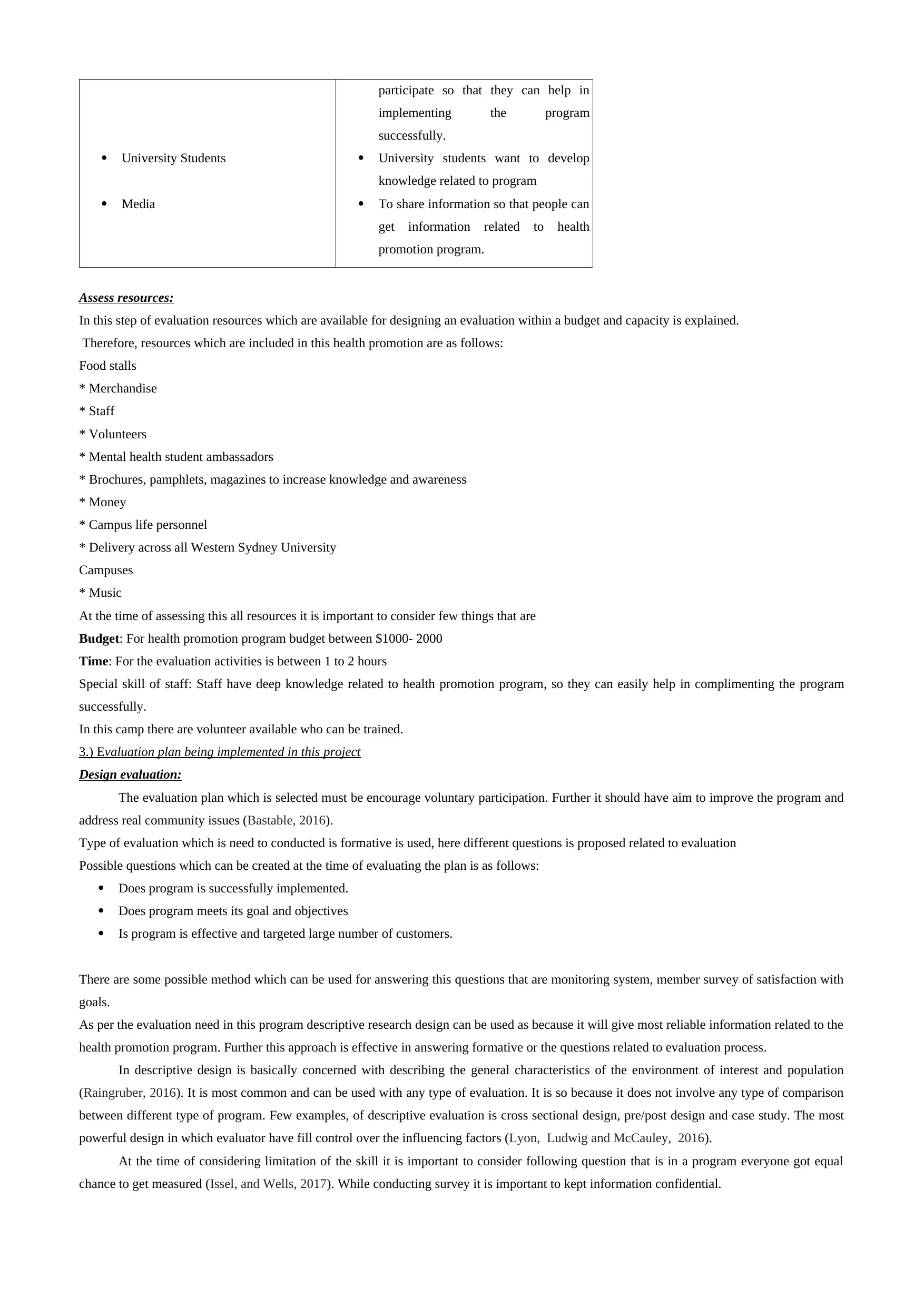
University Students
Media
participate so that they can help in
implementing the program
successfully.
University students want to develop
knowledge related to program
To share information so that people can
get information related to health
promotion program.
Assess resources:
In this step of evaluation resources which are available for designing an evaluation within a budget and capacity is explained.
Therefore, resources which are included in this health promotion are as follows:
Food stalls
* Merchandise
* Staff
* Volunteers
* Mental health student ambassadors
* Brochures, pamphlets, magazines to increase knowledge and awareness
* Money
* Campus life personnel
* Delivery across all Western Sydney University
Campuses
* Music
At the time of assessing this all resources it is important to consider few things that are
Budget: For health promotion program budget between $1000- 2000
Time: For the evaluation activities is between 1 to 2 hours
Special skill of staff: Staff have deep knowledge related to health promotion program, so they can easily help in complimenting the program
successfully.
In this camp there are volunteer available who can be trained.
3.) Evaluation plan being implemented in this project
Design evaluation:
The evaluation plan which is selected must be encourage voluntary participation. Further it should have aim to improve the program and
address real community issues (Bastable, 2016).
Type of evaluation which is need to conducted is formative is used, here different questions is proposed related to evaluation
Possible questions which can be created at the time of evaluating the plan is as follows:
Does program is successfully implemented.
Does program meets its goal and objectives
Is program is effective and targeted large number of customers.
There are some possible method which can be used for answering this questions that are monitoring system, member survey of satisfaction with
goals.
As per the evaluation need in this program descriptive research design can be used as because it will give most reliable information related to the
health promotion program. Further this approach is effective in answering formative or the questions related to evaluation process.
In descriptive design is basically concerned with describing the general characteristics of the environment of interest and population
(Raingruber, 2016). It is most common and can be used with any type of evaluation. It is so because it does not involve any type of comparison
between different type of program. Few examples, of descriptive evaluation is cross sectional design, pre/post design and case study. The most
powerful design in which evaluator have fill control over the influencing factors (Lyon, Ludwig and McCauley, 2016).
At the time of considering limitation of the skill it is important to consider following question that is in a program everyone got equal
chance to get measured (Issel, and Wells, 2017). While conducting survey it is important to kept information confidential.
Media
participate so that they can help in
implementing the program
successfully.
University students want to develop
knowledge related to program
To share information so that people can
get information related to health
promotion program.
Assess resources:
In this step of evaluation resources which are available for designing an evaluation within a budget and capacity is explained.
Therefore, resources which are included in this health promotion are as follows:
Food stalls
* Merchandise
* Staff
* Volunteers
* Mental health student ambassadors
* Brochures, pamphlets, magazines to increase knowledge and awareness
* Money
* Campus life personnel
* Delivery across all Western Sydney University
Campuses
* Music
At the time of assessing this all resources it is important to consider few things that are
Budget: For health promotion program budget between $1000- 2000
Time: For the evaluation activities is between 1 to 2 hours
Special skill of staff: Staff have deep knowledge related to health promotion program, so they can easily help in complimenting the program
successfully.
In this camp there are volunteer available who can be trained.
3.) Evaluation plan being implemented in this project
Design evaluation:
The evaluation plan which is selected must be encourage voluntary participation. Further it should have aim to improve the program and
address real community issues (Bastable, 2016).
Type of evaluation which is need to conducted is formative is used, here different questions is proposed related to evaluation
Possible questions which can be created at the time of evaluating the plan is as follows:
Does program is successfully implemented.
Does program meets its goal and objectives
Is program is effective and targeted large number of customers.
There are some possible method which can be used for answering this questions that are monitoring system, member survey of satisfaction with
goals.
As per the evaluation need in this program descriptive research design can be used as because it will give most reliable information related to the
health promotion program. Further this approach is effective in answering formative or the questions related to evaluation process.
In descriptive design is basically concerned with describing the general characteristics of the environment of interest and population
(Raingruber, 2016). It is most common and can be used with any type of evaluation. It is so because it does not involve any type of comparison
between different type of program. Few examples, of descriptive evaluation is cross sectional design, pre/post design and case study. The most
powerful design in which evaluator have fill control over the influencing factors (Lyon, Ludwig and McCauley, 2016).
At the time of considering limitation of the skill it is important to consider following question that is in a program everyone got equal
chance to get measured (Issel, and Wells, 2017). While conducting survey it is important to kept information confidential.
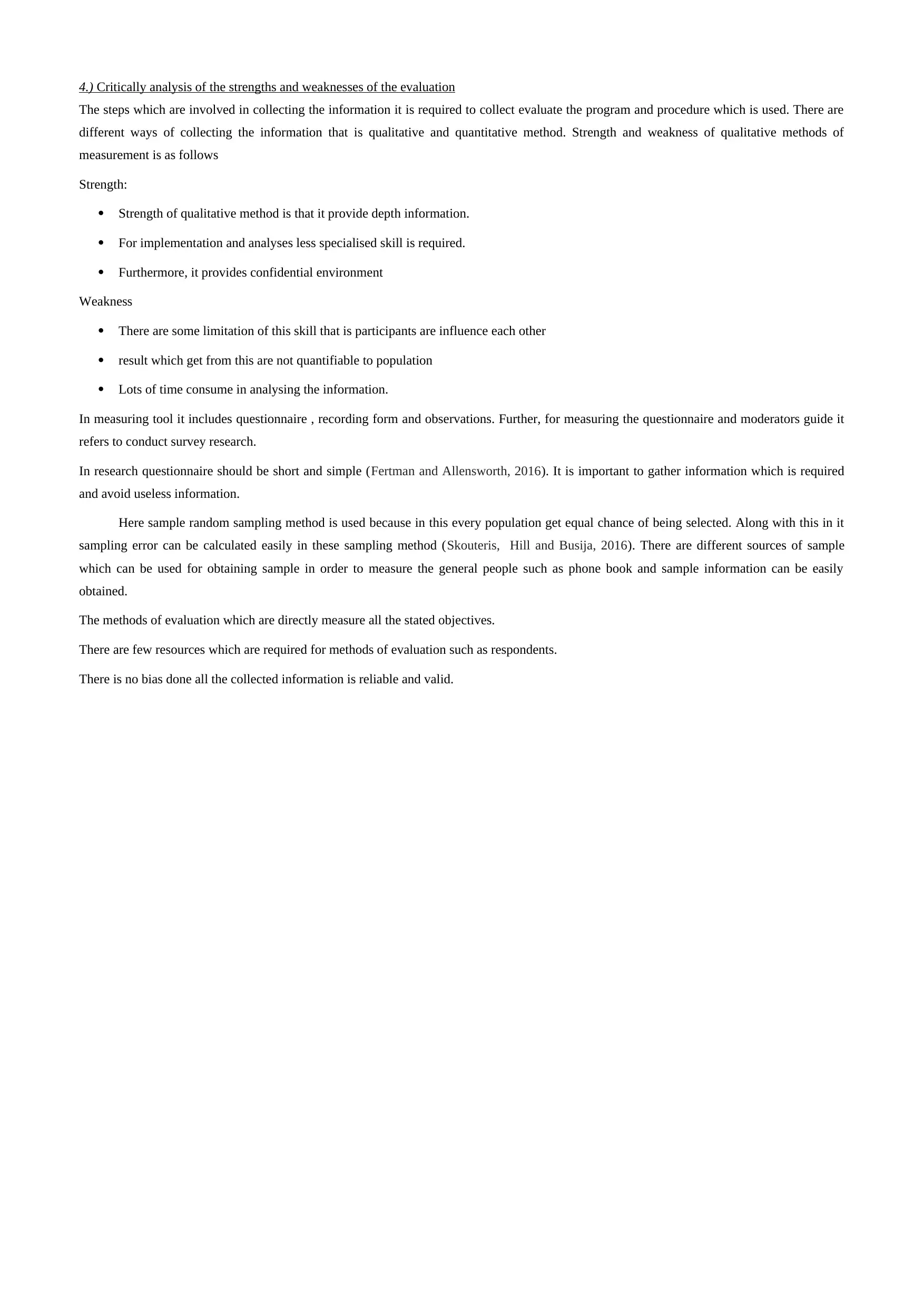
4.) Critically analysis of the strengths and weaknesses of the evaluation
The steps which are involved in collecting the information it is required to collect evaluate the program and procedure which is used. There are
different ways of collecting the information that is qualitative and quantitative method. Strength and weakness of qualitative methods of
measurement is as follows
Strength:
Strength of qualitative method is that it provide depth information.
For implementation and analyses less specialised skill is required.
Furthermore, it provides confidential environment
Weakness
There are some limitation of this skill that is participants are influence each other
result which get from this are not quantifiable to population
Lots of time consume in analysing the information.
In measuring tool it includes questionnaire , recording form and observations. Further, for measuring the questionnaire and moderators guide it
refers to conduct survey research.
In research questionnaire should be short and simple (Fertman and Allensworth, 2016). It is important to gather information which is required
and avoid useless information.
Here sample random sampling method is used because in this every population get equal chance of being selected. Along with this in it
sampling error can be calculated easily in these sampling method (Skouteris, Hill and Busija, 2016). There are different sources of sample
which can be used for obtaining sample in order to measure the general people such as phone book and sample information can be easily
obtained.
The methods of evaluation which are directly measure all the stated objectives.
There are few resources which are required for methods of evaluation such as respondents.
There is no bias done all the collected information is reliable and valid.
The steps which are involved in collecting the information it is required to collect evaluate the program and procedure which is used. There are
different ways of collecting the information that is qualitative and quantitative method. Strength and weakness of qualitative methods of
measurement is as follows
Strength:
Strength of qualitative method is that it provide depth information.
For implementation and analyses less specialised skill is required.
Furthermore, it provides confidential environment
Weakness
There are some limitation of this skill that is participants are influence each other
result which get from this are not quantifiable to population
Lots of time consume in analysing the information.
In measuring tool it includes questionnaire , recording form and observations. Further, for measuring the questionnaire and moderators guide it
refers to conduct survey research.
In research questionnaire should be short and simple (Fertman and Allensworth, 2016). It is important to gather information which is required
and avoid useless information.
Here sample random sampling method is used because in this every population get equal chance of being selected. Along with this in it
sampling error can be calculated easily in these sampling method (Skouteris, Hill and Busija, 2016). There are different sources of sample
which can be used for obtaining sample in order to measure the general people such as phone book and sample information can be easily
obtained.
The methods of evaluation which are directly measure all the stated objectives.
There are few resources which are required for methods of evaluation such as respondents.
There is no bias done all the collected information is reliable and valid.
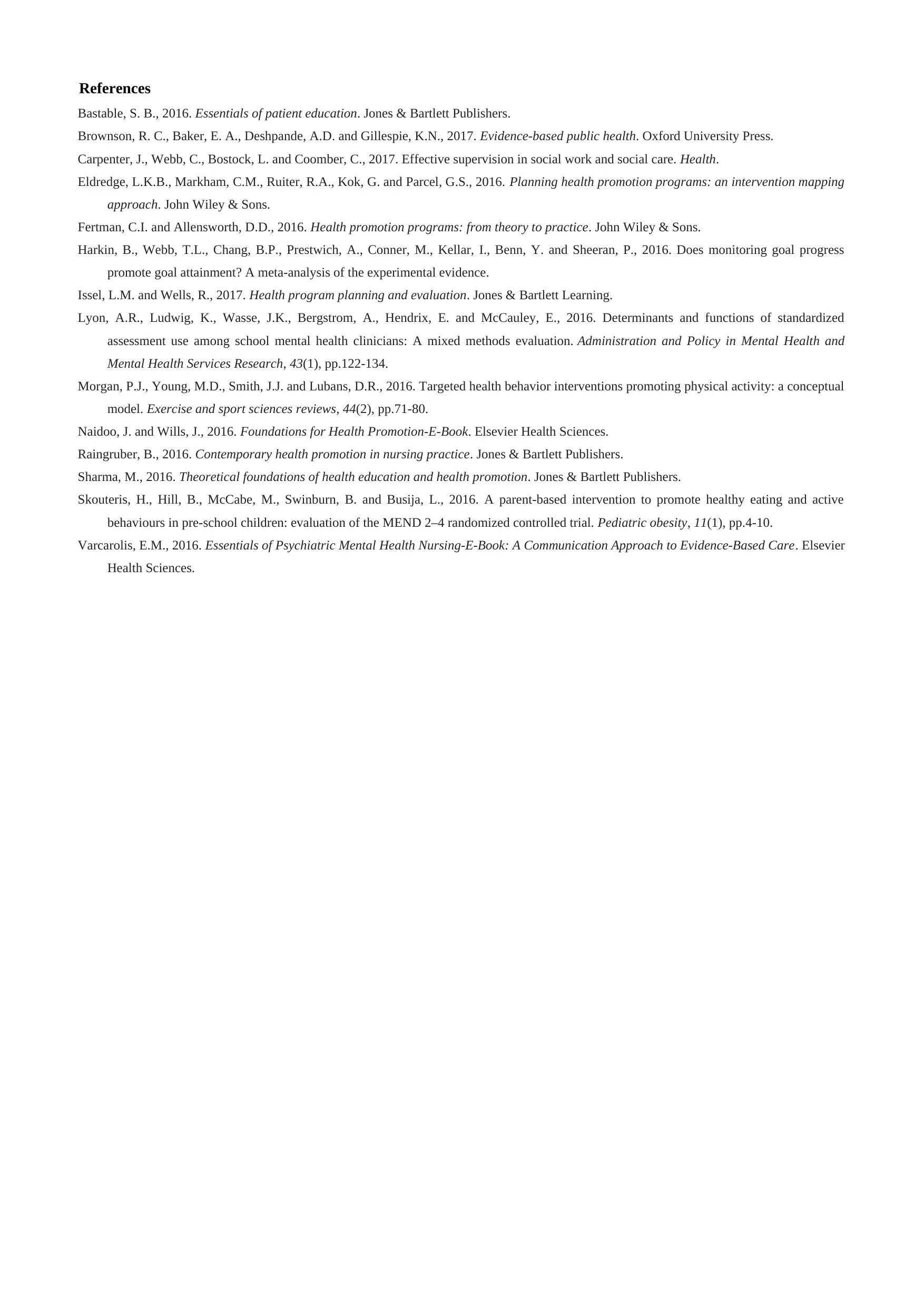
References
Bastable, S. B., 2016. Essentials of patient education. Jones & Bartlett Publishers.
Brownson, R. C., Baker, E. A., Deshpande, A.D. and Gillespie, K.N., 2017. Evidence-based public health. Oxford University Press.
Carpenter, J., Webb, C., Bostock, L. and Coomber, C., 2017. Effective supervision in social work and social care. Health.
Eldredge, L.K.B., Markham, C.M., Ruiter, R.A., Kok, G. and Parcel, G.S., 2016. Planning health promotion programs: an intervention mapping
approach. John Wiley & Sons.
Fertman, C.I. and Allensworth, D.D., 2016. Health promotion programs: from theory to practice. John Wiley & Sons.
Harkin, B., Webb, T.L., Chang, B.P., Prestwich, A., Conner, M., Kellar, I., Benn, Y. and Sheeran, P., 2016. Does monitoring goal progress
promote goal attainment? A meta-analysis of the experimental evidence.
Issel, L.M. and Wells, R., 2017. Health program planning and evaluation. Jones & Bartlett Learning.
Lyon, A.R., Ludwig, K., Wasse, J.K., Bergstrom, A., Hendrix, E. and McCauley, E., 2016. Determinants and functions of standardized
assessment use among school mental health clinicians: A mixed methods evaluation. Administration and Policy in Mental Health and
Mental Health Services Research, 43(1), pp.122-134.
Morgan, P.J., Young, M.D., Smith, J.J. and Lubans, D.R., 2016. Targeted health behavior interventions promoting physical activity: a conceptual
model. Exercise and sport sciences reviews, 44(2), pp.71-80.
Naidoo, J. and Wills, J., 2016. Foundations for Health Promotion-E-Book. Elsevier Health Sciences.
Raingruber, B., 2016. Contemporary health promotion in nursing practice. Jones & Bartlett Publishers.
Sharma, M., 2016. Theoretical foundations of health education and health promotion. Jones & Bartlett Publishers.
Skouteris, H., Hill, B., McCabe, M., Swinburn, B. and Busija, L., 2016. A parent‐based intervention to promote healthy eating and active
behaviours in pre‐school children: evaluation of the MEND 2–4 randomized controlled trial. Pediatric obesity, 11(1), pp.4-10.
Varcarolis, E.M., 2016. Essentials of Psychiatric Mental Health Nursing-E-Book: A Communication Approach to Evidence-Based Care. Elsevier
Health Sciences.
Bastable, S. B., 2016. Essentials of patient education. Jones & Bartlett Publishers.
Brownson, R. C., Baker, E. A., Deshpande, A.D. and Gillespie, K.N., 2017. Evidence-based public health. Oxford University Press.
Carpenter, J., Webb, C., Bostock, L. and Coomber, C., 2017. Effective supervision in social work and social care. Health.
Eldredge, L.K.B., Markham, C.M., Ruiter, R.A., Kok, G. and Parcel, G.S., 2016. Planning health promotion programs: an intervention mapping
approach. John Wiley & Sons.
Fertman, C.I. and Allensworth, D.D., 2016. Health promotion programs: from theory to practice. John Wiley & Sons.
Harkin, B., Webb, T.L., Chang, B.P., Prestwich, A., Conner, M., Kellar, I., Benn, Y. and Sheeran, P., 2016. Does monitoring goal progress
promote goal attainment? A meta-analysis of the experimental evidence.
Issel, L.M. and Wells, R., 2017. Health program planning and evaluation. Jones & Bartlett Learning.
Lyon, A.R., Ludwig, K., Wasse, J.K., Bergstrom, A., Hendrix, E. and McCauley, E., 2016. Determinants and functions of standardized
assessment use among school mental health clinicians: A mixed methods evaluation. Administration and Policy in Mental Health and
Mental Health Services Research, 43(1), pp.122-134.
Morgan, P.J., Young, M.D., Smith, J.J. and Lubans, D.R., 2016. Targeted health behavior interventions promoting physical activity: a conceptual
model. Exercise and sport sciences reviews, 44(2), pp.71-80.
Naidoo, J. and Wills, J., 2016. Foundations for Health Promotion-E-Book. Elsevier Health Sciences.
Raingruber, B., 2016. Contemporary health promotion in nursing practice. Jones & Bartlett Publishers.
Sharma, M., 2016. Theoretical foundations of health education and health promotion. Jones & Bartlett Publishers.
Skouteris, H., Hill, B., McCabe, M., Swinburn, B. and Busija, L., 2016. A parent‐based intervention to promote healthy eating and active
behaviours in pre‐school children: evaluation of the MEND 2–4 randomized controlled trial. Pediatric obesity, 11(1), pp.4-10.
Varcarolis, E.M., 2016. Essentials of Psychiatric Mental Health Nursing-E-Book: A Communication Approach to Evidence-Based Care. Elsevier
Health Sciences.
1 out of 7
Related Documents
Your All-in-One AI-Powered Toolkit for Academic Success.
+13062052269
info@desklib.com
Available 24*7 on WhatsApp / Email
![[object Object]](/_next/static/media/star-bottom.7253800d.svg)
Unlock your academic potential
© 2024 | Zucol Services PVT LTD | All rights reserved.





